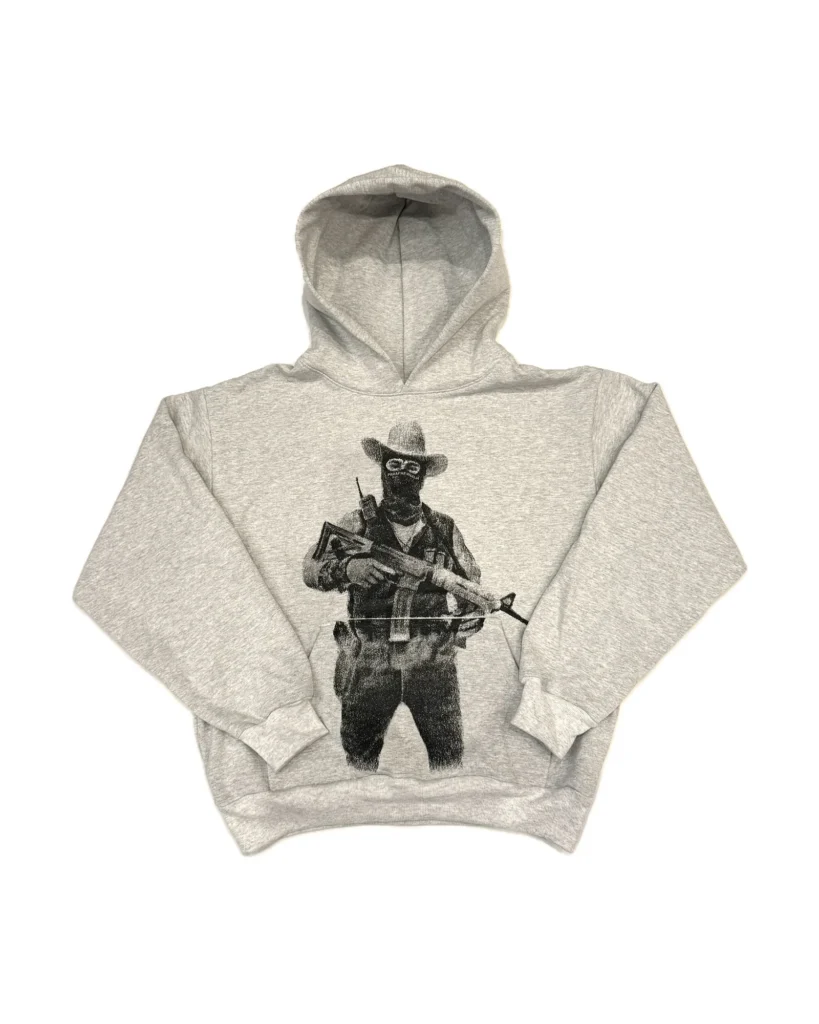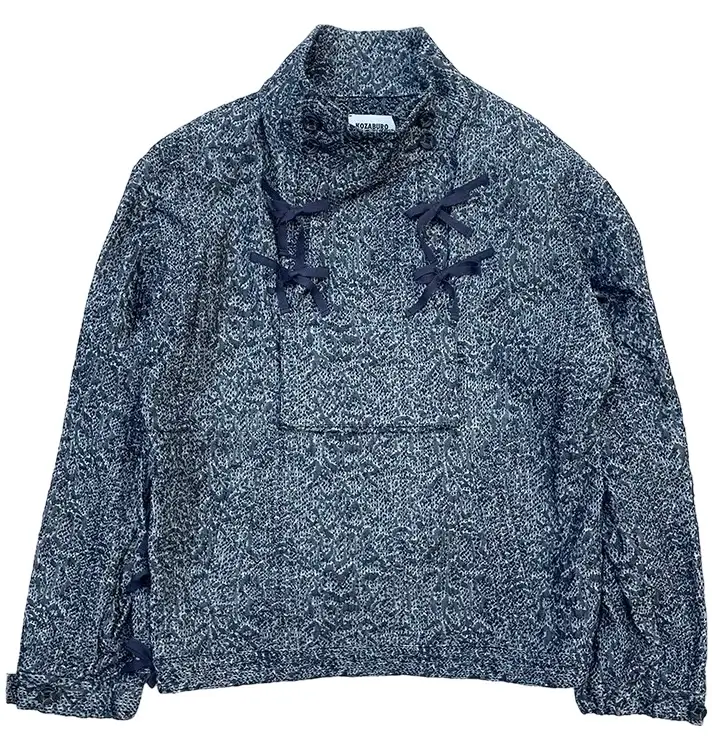Fashion has always been a vessel for rebellion, subversion, and storytelling. From Vivienne Westwood’s anarchic slogans to Jean-Paul Gaultier’s boundary-pushing silhouettes, designers have long used clothing to provoke and challenge societal norms. Enter PARAPHERNALIA, a brand known for its daring visual narratives and cryptic cultural references. Their CARTEL hoodie—adorned with a stark, high-contrast depiction of a masked figure armed and dressed in cowboy attire—pushes this tradition into even more unsettling and potent territory.
In a world where fashion often leans toward either hyper-polished minimalism or mass-appeal streetwear, PARAPHERNALIA’s CARTEL hoodie disrupts by confronting our collective discomfort. Through stark imagery, it blurs the line between fashion, art, and political commentary.
The design: a portrait of tension
At first glance, the CARTEL hoodie is visually striking yet deceptively simple. A light grey base serves as a neutral canvas for the stark black graphic: a figure in a cowboy hat and bandana, brandishing a rifle. Emblazoned across the bandana is the word “PARAPHERNALIA,” an immediate clue to the brand’s audacious identity.
The image is layered with conflicting symbols: cowboy ruggedness, militaristic aggression, and urban street aesthetics. This convergence of styles challenges viewers to consider who wears power and how it is performed. It also taps into contemporary anxieties around surveillance, violence, and the constructed myth of the American outlaw.
Historical context: the outlaw as icon
The iconography of the masked figure with a firearm is deeply rooted in Western and global visual culture. In American myth, the cowboy stands as a symbol of rugged individualism and freedom—often idealized, sometimes sanitized. Yet the reality of this archetype is steeped in violence, conquest, and frontier lawlessness.
Globally, masked figures have appeared across resistance movements and uprisings, from the Zapatistas in Mexico to guerrilla fighters in Latin America. By merging these global revolutionary symbols with the American cowboy, PARAPHERNALIA’s CARTEL hoodie suggests a universal language of defiance and hidden identity.
This imagery also echoes the art of post-1960s agitprop posters and punk zines, where bandanas and masks were shorthand for anti-authoritarianism. The hoodie becomes a wearable pamphlet, a medium for disseminating a message rather than merely a fashion statement.
Materiality and craft
Beyond its provocative graphics, the hoodie stands out for its construction. Made from heavyweight cotton blends, it balances softness and structure. The dropped shoulders and slightly oversized cut recall classic American sportswear while offering modern comfort. The high-quality silkscreen print technique ensures that the graphic holds up through repeated wear and washing, emphasizing durability as a statement in itself.
This focus on materials aligns with PARAPHERNALIA’s ethos of creating wearable artifacts rather than disposable trends. Every stitch, seam, and surface choice reflects an intentional commitment to longevity and narrative depth.
Literature and semiotics: decoding the visual message
In literary theory, particularly semiotics, every image is a sign composed of signifiers and signified meanings. The CARTEL hoodie’s masked figure acts as a complex signifier: a hybrid character oscillating between folk hero, antihero, and modern urban warrior.
This semiotic richness places the hoodie in conversation with works by authors like Don DeLillo, who dissect the interplay between media, violence, and identity, or Cormac McCarthy, whose cowboys and drifters embody existential struggles against chaotic worlds. The garment, then, becomes a wearable text—an open-ended narrative that each wearer continues with their own body and movement through space.
Contemporary cultural commentary
In an age where performative activism is criticized and authenticity is both demanded and contested, PARAPHERNALIA’s CARTEL hoodie plays with this tension. The wearer embodies an ambiguous figure: Are they supporting a cause, making a critique, or merely adopting an aesthetic?
The hoodie also comments on the commodification of rebellion. In today’s market, even revolutionary iconography can be stripped of meaning and sold as lifestyle branding. By making the imagery so stark and potentially unsettling, PARAPHERNALIA challenges both the wearer and the observer to question the ease with which we consume and aestheticize violence and resistance.
Recent trends: weaponized fashion
Streetwear has long flirted with militaristic and tactical elements. Brands like A-COLD-WALL*, 1017 ALYX 9SM, and Off-White have incorporated straps, harnesses, and utility pockets, echoing the aesthetics of riot gear and survivalist kits.
PARAPHERNALIA’s CARTEL hoodie enters this conversation but pushes it further by foregrounding explicit imagery of armed resistance rather than simply hinting at it through design details. It exposes the latent aggression and fascination with danger that underlies much of contemporary streetwear’s appeal.
The rise of NFTs and digital fashion has also amplified questions around authenticity and the role of narrative in wearable art. Physical pieces like the CARTEL hoodie stand in contrast to purely virtual garments, insisting on touch, weight, and presence as integral to the experience of fashion.
Collectibility and cultural capital
Limited edition runs and drops have transformed hoodies like the CARTEL into collectible items, conferring cultural capital upon those who acquire them. This phenomenon turns the hoodie into more than clothing: it becomes a talisman, a piece of a shared cultural puzzle.
For many wearers, the act of donning this hoodie is less about merging with a uniform community and more about declaring a fragmented, ambiguous position within a chaotic cultural landscape.
Impression: wearing the question
PARAPHERNALIA’s CARTEL hoodie is not simply an article of clothing; it is a question posed in clothed fabric and ink. Who are we when we put on symbols of rebellion? What does it mean to aestheticize resistance? And can a garment simultaneously critique and participate in the systems it depicts?
The hoodie invites these questions rather than answering them, demanding that the wearer and viewer grapple with their discomfort. In this way, it joins a lineage of wearable art that insists on engagement, complexity, and thoughtful tension.
In a world that often urges us toward quick answers and smooth surfaces, the CARTEL hoodie reminds us of the power of rough edges, shadowed meanings, and layered stories. To wear it is to inhabit a provocation—an act of fashion as interrogation, both of society and of the self.
No comments yet.









